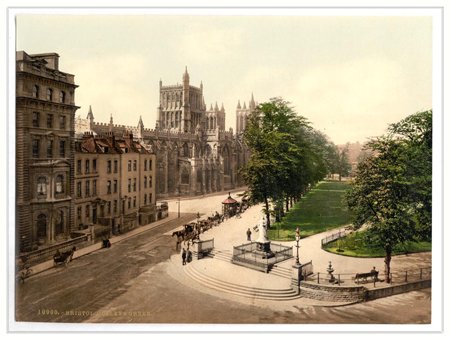For anyone wondering why we had to start from scratch with wilding up an ancient & #39;green& #39;, see my thread. I dug into the curious history of this grassland, the wildlife & history of protects on this site. It& #39;s rather interesting and unexpected... https://twitter.com/jonusher/status/1385316647351771140">https://twitter.com/jonusher/...
This postcard photo by Francis Frith from 1890 shows how College Green once looked. The raised tree area was the green. Under it was an ancient burial ground. Records say bones would occasionally pop up. Going much further back there was also an ancient hay meadow. However...
The green was lowered by 4 feet in 1950, with 75,000 tons of Earth + contents taken away. It appears this was to satisfy the ego of the architect who built the council house - perhaps an attempt to make his erection look more impressive. It removed any wild flora & seed bank.
Vincent Harris was the architect of City Hall, he ordered all the trees, formal promenades, railing, lamps, statue and a High Cross to be removed and the Green lowered. Harris stated that this "would & #39;make& #39; my building" - https://en.wikipedia.org/wiki/College_Green,_Bristol">https://en.wikipedia.org/wiki/Coll...
There was also a road around 3 sides of College Green, from at least the 1800s, which meant any clues about ancient hay meadow remnants beyond the raised area around the Cathedral were also long gone. Old postcard from this site: http://aparcelofribbons.co.uk/category/jamaican-life/page/2/">https://aparcelofribbons.co.uk/category/...
Since then, College Green has been ‘improved’ [that& #39;s horticultural language] for decades. With tough-as-old-boots grasses + fertilisers, landscaping, digging, lowering & lots of repeat returfing, there& #39;s no original heritage seeds + flora to recover.
So although many old religious monuments like this site do have natural heritage and wildlife around them that needs protecting, we don’t know much about what wildlife was once here. I’ve found very little evidence.
This is why habitat is being created from scratch, using a carefully chosen wide range of wild plant species of local provenance, that we know support a very wide range of wildlife [I& #39;ve calculated how much!]. It shows that even a barren template can be revitalised for wildlife.
There will be lots more about the natural history + heritage to come, sharing more about College Green& #39;s interesting story in the future as the project continues. There will be opportunities to get involved. Like this for example:
#FlowersInTheirFootsteps https://www.ispotnature.org/communities/uk-and-ireland/view/project/820924/flowers-in-their-footsteps-college-green-bristol">https://www.ispotnature.org/communiti...
#FlowersInTheirFootsteps https://www.ispotnature.org/communities/uk-and-ireland/view/project/820924/flowers-in-their-footsteps-college-green-bristol">https://www.ispotnature.org/communiti...
The history of public protest goes back hundreds of years on College Green. ‘Flowers in their Footsteps’ alludes to the recent campaigners & @GretaThunberg but also a much longer tradition of Bristolians standing up for their values and beliefs by gathering on this spot.
Sorry for the typing error in the first part of this thread.
*history of ‘protests’
(not ‘protects’) https://abs.twimg.com/emoji/v2/... draggable="false" alt="🙂" title="Leicht lächelndes Gesicht" aria-label="Emoji: Leicht lächelndes Gesicht">
https://abs.twimg.com/emoji/v2/... draggable="false" alt="🙂" title="Leicht lächelndes Gesicht" aria-label="Emoji: Leicht lächelndes Gesicht">
*history of ‘protests’
(not ‘protects’)

 Read on Twitter
Read on Twitter

![Since then, College Green has been ‘improved’ [that& #39;s horticultural language] for decades. With tough-as-old-boots grasses + fertilisers, landscaping, digging, lowering & lots of repeat returfing, there& #39;s no original heritage seeds + flora to recover. Since then, College Green has been ‘improved’ [that& #39;s horticultural language] for decades. With tough-as-old-boots grasses + fertilisers, landscaping, digging, lowering & lots of repeat returfing, there& #39;s no original heritage seeds + flora to recover.](https://pbs.twimg.com/media/Ezxh9E6XoAQlOKW.jpg)


